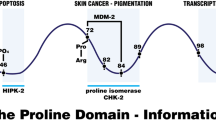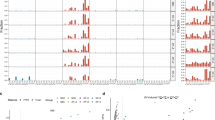Abstract
To assess the role of the p53 tumor suppressor gene in skin carcinogenesis by UV radiation, mice constitutively lacking one or both copies of the functional p53 gene were compared to wild-type mice for their susceptibility to UV carcinogenesis. Heterozygous mice showed greatly increased susceptibility to skin cancer induction, and homozygous p53 knockout mice were even more susceptible. Accelerated tumor development in the heterozygotes was not associated with loss of the remaining wild-type allele of p53, as reported for tumors induced by other carcinogens, but in many cases was associated with UV-induced mutations in p53. Tumors arose on the ears and dorsal skin of mice of all three genotypes, and homozygous knockout mice also developed ocular tumors, mainly melanomas. Skin tumors in the p53 knockout mice were predominately squamous cell carcinomas and were associated with premalignant lesions resembling actinic keratoses, whereas those in the heterozygous and wild-type mice were mainly sarcomas. These results demonstrate the importance of p53 in protecting against UV-induced cancers, particularly in the eye and epidermis.
This is a preview of subscription content, access via your institution
Access options
Subscribe to this journal
Receive 50 print issues and online access
$259.00 per year
only $5.18 per issue
Buy this article
- Purchase on Springer Link
- Instant access to full article PDF
Prices may be subject to local taxes which are calculated during checkout




Similar content being viewed by others
References
Ananthaswamy HN, Loughlin SM, Cox P, Evans RL, Ullrich SE and Kripke ML. . 1997 Nature Med. 3: 510–514.
Ananthaswamy HN, Fourtanier A, Evans RL, Tison S, Medaisko C, Ullrich SE and Kripke ML. . 1998 Photochem. Photobiol. 67: 227–232.
Brash DE, Rudolph JA, Simon JA, Lin A, Mckenna GJ, Baden HP, Halperin AJ and Ponten J. . 1991 Proc. Natl. Acad. Sci. USA 88: 10124–10128.
Cheo DL, Meira LB, Hammer RE, Burns DK, Doughty ATB and Friedberg EC. . 1996 Curr. Biol. 6: 1691–1694.
Donawho CK and Kripke ML. . 1991 Cancer Metastasis Rev. 10: 177–188.
Donehower LA, Harvey M, Slagle BL, McArthur MJ, Montgomery Jr CA, Butel JS and Bradley A. . 1992 Nature 356: 215–221.
Hartwell LH and Weinert TA. . 1989 Science 246: 629–634.
Hollstein M, Sidransky D, Vogelstein B and Harris CC. . 1991 Science 253: 49–53.
Jacks T, Remington L, Williams BO, Schmitt EM, Halachmi S, Bronson RT and Weinberg RA. . 1994 Curr. Biol. 4: 1–7.
Kanjilal S, Pierceall WE, Cummings KK, Kripke ML and Ananthaswamy HN. . 1993 Cancer Res. 53: 2961–2964.
Kemp CJ, Donehower LA, Bradley A and Balmain A. . 1993 Cell 74: 813–822.
Kemp CJ, Wheldon T and Balmain A. . 1994 Nature Genetics 8: 66–69.
Kraemer KH, Lee MM and Scotto J. . 1987 Arch. Dermatol. 123: 241–250.
Kripke ML. . 1977 Cancer Res. 37: 1395–1400.
Lane DP. . 1992 Nature 358: 15–16.
Li G, Tron V and Ho V. . 1998 J. Invest. Dermatol. 110: 72–75.
Malkin D, Li FP, Strong LC, Fraumeni Jr JF, Nelson CE, Kim DH, Kassel J, Gryka MA, Bischoff FZ, Tainsky MA and Friend SH. . 1990 Science 250: 1233–1238.
Nakazawa H, English D, Randell PL, Nakazawa K, Martel N, Armstrong BK and Yamasaki H. . 1994 Proc. Natl. Acad. Sci. USA 91: 360–364.
Ziegler A, Jonason AS, Leffell DJ, Simon JA, Sharma HW, Kimmelman J, Remington L, Jacks T and Brash DE. . 1994 Nature 372: 773–776.
Acknowledgements
We thank Clifton L Stephens, DVM, PhD for assistance with histopathological analysis of the tumor specimens. These studies were supported by NIH grants P01CA68233 (MLK), R01CA46523 (HNA), and CA16672 (Institutional core grant).
Author information
Authors and Affiliations
Rights and permissions
About this article
Cite this article
Jiang, W., Ananthaswamy, H., Muller, H. et al. p53 protects against skin cancer induction by UV-B radiation. Oncogene 18, 4247–4253 (1999). https://doi.org/10.1038/sj.onc.1202789
Received:
Revised:
Accepted:
Published:
Issue Date:
DOI: https://doi.org/10.1038/sj.onc.1202789
Keywords
This article is cited by
-
Modeling transcriptomic age using knowledge-primed artificial neural networks
npj Aging and Mechanisms of Disease (2021)
-
Integrative transcriptomic analysis for linking acute stress responses to squamous cell carcinoma development
Scientific Reports (2020)
-
Mouse models of UV-induced melanoma: genetics, pathology, and clinical relevance
Laboratory Investigation (2017)
-
PLCε signaling in cancer
Journal of Cancer Research and Clinical Oncology (2016)
-
Actinic Keratosis: Rationale and Management
Dermatology and Therapy (2014)



